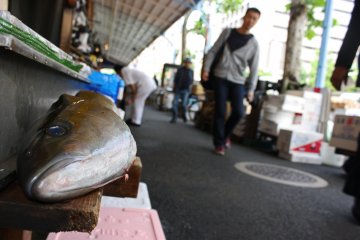
Tsukiji Outer Market
Sleiman AziziTsukiji's Outer Market is famous for its history, its food and its blue-collar atmosphere. A maze of streets and alleys, 500 stores ply their trade serving all kinds of food, including, of course, sushi.

Encounter all types of fresh foods and traditional Japanese foods in Tsukiji’s Outer Market. The market combines wholesale and retail shops into charm that lines the streets of the area and offers a unique perspective on Japan and even some original Japanese dishes.
The Tsukiji Market was once a wholesale market for professionals and a place that tourists frequently visited. Particularly famous was the morning fish market where freshly caught fish would be cut and sold in large open areas of the market. Nowadays, the wholesale fish market has since moved to Toyosu (about 2 km away) back in 2018. However, this doesn’t mean that the Outer Tsukiji Market isn’t worth visiting.
Colorful slices of fresh-sliced sashimi, dried seaweed, fruits, vegetables, single-servings of food, and kitchen utensils; you can find all this and more at the Outer Market in Tsukiji. In fact, many of the shops in the Outer Market simply bring their wares from Toyosu. In the Outer Market, there are buildings that are more than 80 years old. Many owners still use the first floor for their shops and live on the upper floors above street level creating an intricate maze of homes and shops. But even with this layout, Tsukiji Outer Market is a fascinating place to visit and shop. Especially for sushi and sashimi aficionados.
The birth of the fish market as its known today began in 1657 when Edo was devastated by a great fire. Land was reclaimed from Tokyo Bay and named Tsukiji (築地), which means "constructed land". What was once a quiet living quarters for samurai families and shrines—one of which still sits at the back corner of the Tsukiji Market, "Namiyoke" offering protection from waves—became a hustling center of prosperous markets after the 1923 Great Kanto Earthquake.
Even though half of the fish market has moved to Toyosu, the Outer Market remains a fascinating experience where tourists can rub elbows with locals and get a sense of where the fresh seafood of Tokyo comes from. The market typically opens for business at 9 am and goes on until 3 pm. This early closing time means that you want to get there early for the freshest foods before they sell out or are closed for the day.
Tokyo's wholesale fish market moved to Toyosu in October 2018. Note that many shops are closed on Sundays and some Wednesdays.
The Tsukiji Outer Market is a haven of shopping for home utensils and kitchenware. The selection of knives is especially good at the market and they come in almost every size, color, and function. There are also plenty of new, trendy utensils for you to check out.
In addition to slabs of freshly-cut fish, seaweed, and other fresh seafood and shellfish you will find plenty of food to snack on along your way through the market. You’ll not only find gourmet Japanese specialties but also the famed Tsukiji sushi, sashimi, and even ramen.
A 1-minute walk from Tsukijishijo Station (Oedo Line) and Tsukiji Station (Hibiya Line), or a 3-minute walk from Higashi-Ginza Station (Asakusa Line)

Tsukiji's Outer Market is famous for its history, its food and its blue-collar atmosphere. A maze of streets and alleys, 500 stores ply their trade serving all kinds of food, including, of course, sushi.
![Chuka Soba Inoue, Tokyo [Closed] Chuka Soba Inoue, Tokyo [Closed]](https://a3.cdn.japantravel.com/photo/25804-136864/360x240!/tokyo-chuka-soba-inoue-tokyo-ramen-136864.jpg)
Chuka Soba Inoue is a well-known ramen shop in the Tsukiji outer market. The shop serves only classic shoyu ramen with a light but delicious broth with bamboo and thin slices of lean pork.
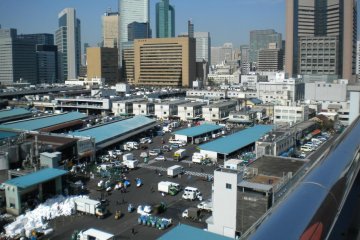
A tour of Tsukiji's Outer Market offers a delicious inside look at a Tokyo institution.
![Sushi Yamazaki, Tsukiji Fish Market [Closed] Sushi Yamazaki, Tsukiji Fish Market [Closed]](https://a0.cdn.japantravel.com/photo/4228-26869/360x240!/tokyo-sushi-yamazaki-tsukiji-fish-market-26869.jpg)
When you go to Tokyo's fish market, you surely don’t just want to look at things, but you want to try the sushi coming directly from the market, right? Where else if not
![Tsukiji Fish Market [Closed] Tsukiji Fish Market [Closed]](https://a0.cdn.japantravel.com/photo/16366-96877/360x240!/tokyo-pelelangan-tuna-tsukiji-96877.jpg)
Tsukiji Market is the largest and busiest wholesale market in Japan. Besides fish, it also sells vegetables and fruits. It is one of the biggest fish markets in the world and handles 2,000 tons of marine product per day
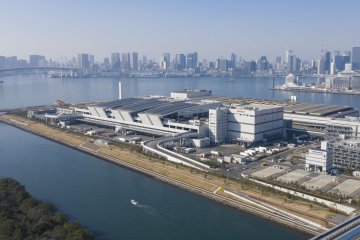
Tokyo's iconic Tsukiji Fish Market moves to its new location in Toyosu.
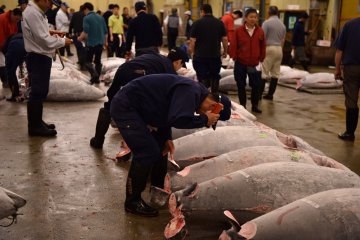
Tokyo's new governor, Yuriko Koike, has decided to postpone the relocation of Tsukiji Fish Market to Toyosu to allow time for final groundwater test results to be released early next year.
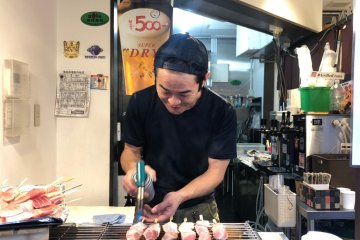
Tsukiji Fish Market is still attracting visitors. Take a Tsukiji Foodies Tour to learn about the history of the market and help find the best food to try there.

Must-visit Tsukiji fish market is the largest wholesale fish market in the world, but time is running out to see the original location.
![Tsukiji Fish Market in Tokyo [Closed] Tsukiji Fish Market in Tokyo [Closed]](https://a0.cdn.japantravel.com/photo/364-17477/360x240!/tokyo-tsukiji-fish-market-17477.jpg)
Enjoy the unique and exciting experience of Japan's largest wholesale fish market.

Don’t miss the opportunity to visit the tuna auction at Tsukiji Fish Market in Tokyo. Get up early, it's on a first come first serve basis.
![Tsukiji Fish Market in Tokyo [Closed] Tsukiji Fish Market in Tokyo [Closed]](https://a1.cdn.japantravel.com/photo/34786-164894/360x240!/tokyo-tsukiji-fish-market-164894.jpg)
One of Tokyo's top attractions, Tsukiji Fish Market is one of the biggest wholesale markets in the world, a fascinating view behind the scenes in this sushi-loving nation.

Seasonal oyster ramen at Tokyo's Tsukiji fish market: A unique type of ramen worth making the morning trip for.
![Tsukiji Fish Market in Tokyo [Closed] [Closed] Tsukiji Fish Market in Tokyo [Closed] [Closed]](https://a1.cdn.japantravel.com/photo/13934-81492/360x240!/tokyo-tsukiji-fish-market-in-tokyo-81492.jpg)
An absolute must for seafood lovers (and a recommendation for all) is a visit to Tokyo’s Tsukiji Fish Market. If you’re eager and up early, you can catch the tuna auction; otherwise, visit the many stalls and restaurants for some delicious, fresh seafood.
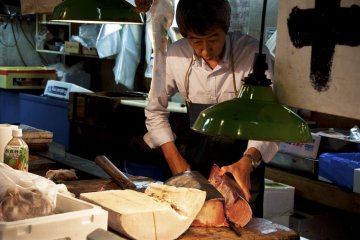
Japan has a rich cultural heritage with many ancient arts and traditions. It has the art of comic storytelling, martial arts or the kimono. Japan also has a long history
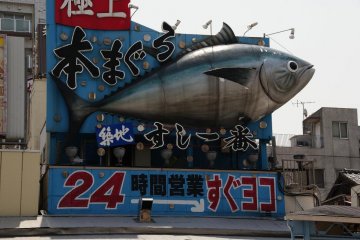
Eating at the food stalls that line the road to Ginza near Tokyo's Tsukiji Fish Market

Explore the many and varied products on sale at the Tsukiji Fish Market in Tokyo. See retailers selling all kinds of food, and try to grab a bite at one of the popular stalls that line the streets.
![Tsukiji Central Wholesale Market [Closed] Tsukiji Central Wholesale Market [Closed]](https://a1.cdn.japantravel.com/photo/3824-23842/360x240!/tokyo-tsukiji-central-wholesale-market-23842.jpg)
More commonly known as the Tsukiji Fish Market, this place supplies most of the seafood to the restaurants and markets in Tokyo.
![Toyo-chan, Tsukiji Market [Closed] Toyo-chan, Tsukiji Market [Closed]](https://a3.cdn.japantravel.com/photo/2535-15193/360x240!/tokyo-toyo-chan-tsukiji-area-15193.jpg)
If you’re still jet lagged from the flight and looking for a satisfying non-sushi breakfast while visiting the Tsukiji market, check out Toyo-chan.
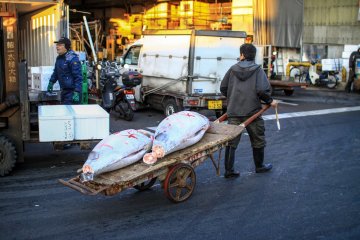
A butchers knife simply won't cut it (no pun intended) when it comes to a 489lb Tuna.
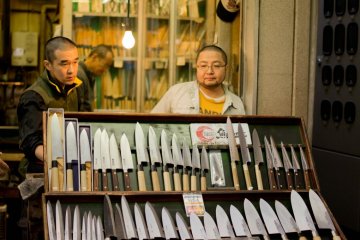
Being a masochist, I decided to murder my weekend by getting up at the crack of dawn to visit Tsukiji. I missed the tuna auction (at around 5:20), but enjoyed the bustle.
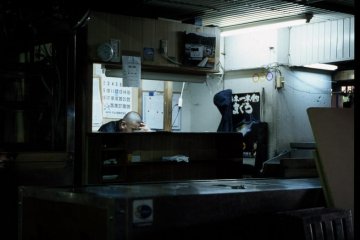
Try the freshest sushi and sashimi, hand made before your eyes at the counter at this local eatery in the working town of Tsukiji.

Oakwood Premier Tokyo comes from a brand of standout luxury hotel & service apartments right at the heart of the Tokyo metropolis. It is located in the business hub of Marunouchi with JR Tokyo Station in close proximity. This will allow guests and travelers to easily access the city's extensive transport network and visit various landmarks such as Imperial Palace, Tsukiji Fish Market, Ginza and Shopping District. Boasting 123 luxurious apartments on the upper floors of a multi-serviced complex, each room offers a magnificent view of the city, not to mention all furnished and a fully-equipped kitchen set which is rarely seen in your everyday service apartment. Without doubt, these spacious tranquil retreats are curated to give you the amenities and services of a luxury hotel and a feeling of home. They are good options for both business executives and leisure travelers from one night of a short-stay to a few weeks/months of mid-to-long-term stay.

NOHGA HOTEL AKIHABARA TOKYO is conveniently located in the midst of the electric town Akihabara, also known as the capital of manga and anime. In addition, this neighborhood has an abundance of tech shops, maid cafes and a variety of restaurants. With just a 6-minute walk away from Akihabara station, it provides easy access to explore other areas nearby such as Ueno and Asakusa. This hotel embodies the rich cultures of music, art and food. Nohga’s concept of music is derived from Akihabara’s local history, starting as a district of radio and wireless component merchants in the late 1920s. The artistic and luxurious space throughout the hotel is achieved by featuring art and amenities designed in collaboration with craftsmen from around Japan. As for the food menu, it’s seasonal fresh ingredients are sourced domestically. The glasses and dinnerware served are collaborations with stores in the surrounding area. All 120 non-smoking guest rooms feature an ensuite bathroom with a rain shower, in-room safety box, mini fridge, USB plugs, free Wi-Fi, a high-quality bluetooth speaker and flatscreen TV with original music and film. The lounge area and a compact 24-hour gym can be found near the reception on the second floor. Services include laundry (from 2,750JPY) and a 24-hour front desk with a check-in time of 3PM and check-out time of 11AM. For sightseeing you can rent a Tokyobike for the day (2,000 JPY/day) to explore the vicinity.

ANA Holiday Inn Tokyo Bay (previously Dai-ichi Hotel Tokyo Seafort) is a 132-room hotel that will provide visitors to Japan’s capital city with an attractive, fresh option in the midscale space. ANA Holiday Inn Tokyo Bay will join a strong portfolio of 10 ANA Holiday Inn open and pipeline hotels across Japan, and become part of the brand’s global footprint of 1,234 open hotels and 278 pipeline properties.
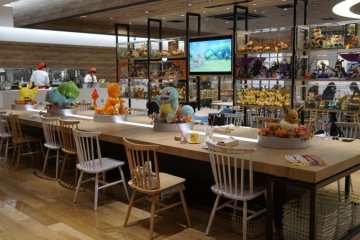
The Pokémon Café in Nihonbashi, which opened in March 2018, is the latest character café in the popular series of games and series in Tokyo. The café and the adjacent Pokémon Center DX store were opened in 1997 on the occasion of the 20th anniversary of the first store. The bright café, which is furnished in warm wood tones, offers main courses, desserts and drinks - all of which are arranged with a focus on one or more Pokémon and some are suitable and limited to certain topics or seasons. You can also find exclusive merchandise here - from plush toys in chef jackets to bowls and cutlery with Pokémon motifs. They also sell Pikachu Sweets, special sweets and products with the most popular of all Pokémon as a motif. A visit to the Pokémon Café is only possible with a prior reservation, time slots can be selected from one month in advance and also in English via the website. It is located on the 5th floor of the Nihombashi Takashimaya Shopping Center, which is not far from the Tokyo and Nihonbashi stations.

Toyosu Market is a wholesale market in Tokyo located in the Koto District. It was built on man-made land in Tokyo Bay and replaces the historic Tsukiji Fish Market, which was previously the capital's famous fish market. Opened October 2018 and is the largest seafood market in the world. The market in turn consists of two separate fish markets, one for auctions and the other for general sale, plus a fruit and vegetable market. There are also restaurants and a variety of options for visitors. Tourists can watch the market from a viewing platform on the second floor and take part in guided auctions and events. However, it is no longer possible, as was previously the case in Tsukiji, for visitors to be directly at the famous tuna events, a platform was built for this, from which one can see into the interior of the market. The modern building complex also offers a roof terrace and a shrine and is easily accessible by bus and train.
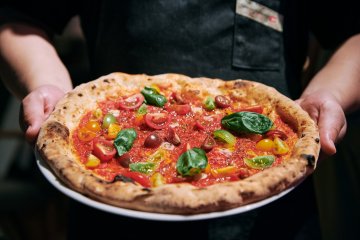
PIZZERIA & BAR NOHGA is an all day dining restaurant interpreting a fusion of “Spanish Italian” cuisine and has a kitchen to table design. There is a casual bar area and restaurant where you can take a peek inside the open kitchen whilst enjoying your meal. Visit the cafe for a range of coffees and teas along with an offering of tapas snacks and seasonal desserts. The cafe also offers an assorted dessert and all-you-can-drink cafe set. Breakfast takes on the art of sharing, where a range of platters are combined with focaccia and your choice of eggs cooked your way. Coming for lunch? Choose from a selection of pizzas, pastas and salads. Each lunch menu is accompanied with homemade soup, iced tea and focaccia. Dinner time offers a range of exquisite tapas and pizzas that can also be shared. Breakfast: 07:00 - 10:00, Lunch 11:30 - 14:30, Cafe 14:30 - 18:00, Dinner: 18:00 - 23:00 with last order at 10pm.
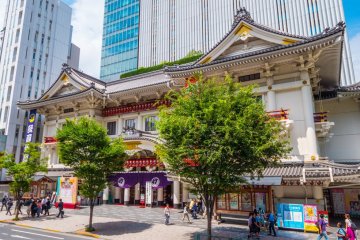
When you think of Japanese theater, you also think of kabuki: demonic-looking masks, elegant kimonos and drums. Often stories are told of old warriors or longing lovers. The beautiful hand-made costumes, the enchanting stage design and the musical background make a journey unforgettable in Kabuki-za. The Kabuki-za in Ginza is Tokyo's premier kabuki theater. The theater was originally built in 1889 by a Meiji-era journalist Fukuchi Gen'ichiro. Fukuchi wrote kabuki plays and kyogen, another form of traditional Japanese theater, for Ichikawa Danjuro IX and others in which he starred. However, after Danjuro IX's death, Fukuchi retired from the theater. Destroyed by several disasters, the building was rebuilt a total of 4 times. If a whole Kabuki piece is too long (a piece can take over 4 hours) or too expensive, there is also the option of purchasing tickets for individual acts. For certain pieces, you can also purchase a G-marc guide on site, which translates what is spoken into English so that you can better understand what is happening on stage.

Caretta Shiodome is a shopping and dining center in the Shiodome area of Minato-ku. It is not only home to cultural institutions such as the Tokyo Advertising Museum, but also offers unique shops and many restaurants with a variety of great dining experiences. There is also a theater a capacity of 1200 seats, where musicals are sometimes performed in Japanese. The restaurants are located 200 meters above the ground. Many restaurants on the 46th and 47th floors offer delicious dishes and fantastic views of Tokyo Tower, Tokyo Skytree, Rainbow Bridge and Ginza. Caretta Shiodome offers a wide range of events all year round, but one of the most exciting events is the impressive winter illumination. [Photo: Mahathir Mohd Yasin / Shutterstock.com]

Hamarikyu Gardens is a traditional landscape garden located on the edge of Tokyo’s Sumida River. During the Edo Period (1603-1868), the grounds were used by successive members of the Tokugawa Shogunate. A small residence was built and the shoguns and their retainers would use the duck hunting ponds on the grounds for sport. The garden changed hands during the Meiji Restoration and became the property of the Imperial Family, with the new name of Hama Detached Palace. After suffering damage during both the Great Kanto Earthquake of 1923 and the air raids of 1945, the garden was given over to the city and opened to the public in 1946. Today, Hamarikyu is one of the nine gardens in the Tokyo Metropolitan Garden system. The garden encompasses 62 acres on the edge of the Tsukiji and Shiodome neighborhoods. The garden’s large pond is the only remaining seawater pond in Tokyo, and sluice gates in the garden regulate the water level based on the tide. A beautiful spot for a restful break in the garden is the Nakajima Tea House, which sits on an island in the garden’s main pond. The teahouse serves a cup of green tea and a selection of traditional sweet to visitors who prefer to enjoy the views with a bit of a refreshment. In recent years, the city has also made great strides in reconstructing several of the historic tea houses that formerly stood in the garden. Both the Matsu no ochaya (Pine Tea House) and the Tsubame no ochaya (Swallow Tea House) have been rebuilt and stand ready to welcome visitors. While the park is beautiful in any season, it is particularly known for its February display of plum blossoms and nanohana (rapeseed). One of the most impressive plants in the garden, however, is the 300-year-old black pine right inside the main gate, whose beauty remains constant no matter the season.